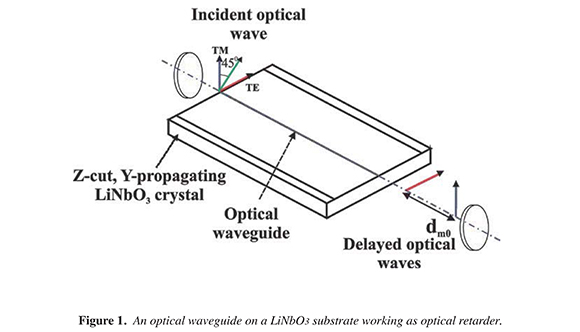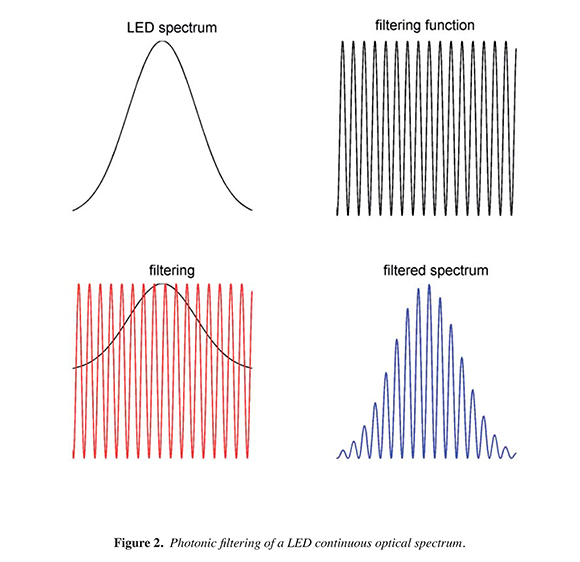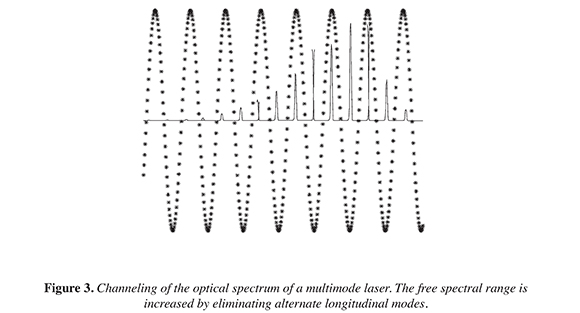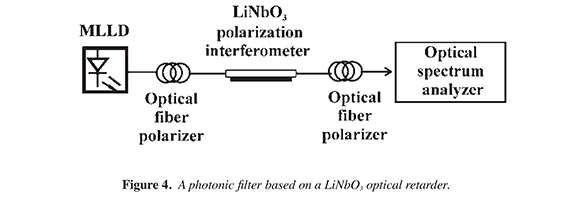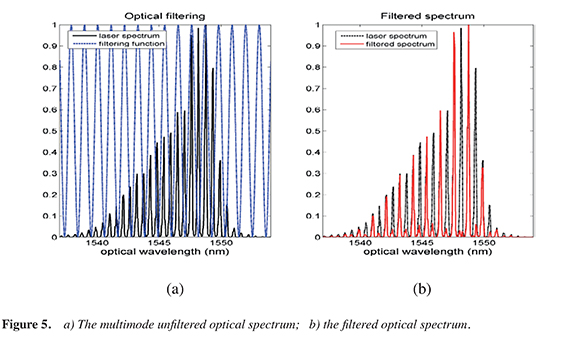Services on Demand
Journal
Article
Indicators
-
 Cited by SciELO
Cited by SciELO -
 Access statistics
Access statistics
Related links
-
 Cited by Google
Cited by Google -
 Similars in
SciELO
Similars in
SciELO -
 Similars in Google
Similars in Google
Share
Revista de Ciencias
Print version ISSN 0121-1935
rev. cienc. vol.19 no.2 Cali July/Dec. 2015
Photonic Filters Using Optical Retarders Based on Birefringent Optical Media
Joel Santos-Aguilar
Centro de Investigación Científica y Educación Superior de Ensenada (CICESE), Ensenada B.C., México
E-mail: jaguilar@cicese.mx
Celso Gutiérrez-Martínez
Instituto Nacional de Astrofísica, Óptica y Electrónica (INAOE), Puebla - México
E-mail: cgutz@inaoep.mx
Received: November 9, 2015
Accepted: December 17, 2015
Abstract
Photonic f lters can be used for f ltering the spectrum of wide-band optical sources such as light emitting diodes (LED) or multimode laser diodes (MMLD). In this work the use of birefringent optical media such as polarization maintaining f ber (PMF) or birefringent optical waveguides on Lithium Niobate (LiNb03) crystal, perform as optical f lters. The birefringent optical media, used as optical retarders, modify the optical spectrum by "channelizing" them. These devices act as photonic f lters, thus modifying an optical spectrum. As reported in this paper, integrated optics photonic f lters are easily implemented by birefringent optical waveguides on LiNbO3 electrooptic crystals. The practical f ltering of LED and be used for MMLD spectra is demonstrated in this work. The photonic f lters can implementing microwave f lters or optoelectronic multiplexing for radio or radio over f ber schemes.
Keywords: photonic f lters, optical delays, broadband optical sources, birefringent optical media.
1. Introduction
Very simple photonic f ltering can be achieved by optical retarders, which modify the optical spectrum of semiconductor LED's and MMLD. The LED optical emission can be f ltered for generating a multimode spectrum; a multimode laser spectrum can be f ltered for eliminating emitted modes. An optical retarder can be easily implemented by birefringent optical media such as PMF or optical waveguides on LiNbO3. The optical retarder introduces an optical delay (0D) or its equivalent optical path-difference (0PD) when 45° polarized light enters the media and is projected in two propagating orthogonal modes, transversal electric (TE) and transversal magnetic (TM), respectively. The two optical modes travel at different velocities thus introducing an OPD, which depends on the optical birefringence and the length of the optical path. The optical delay modif es the optical spectrum by "channeling" it. Such an effect has been described in detail when studying coherence multiplexing of light (Gutiérrez-Martínez et al., 2000). The channeling effect can be matched to the optical spectrum of a multi-longitudinal laser diode and its optical modes can be selectively f ltered as reported in this paper. A photonic f lter based on a birefringent optical waveguide on a lithium niobate (LiNb03) crystal is described in this paper. The proposed photonic f lter is a kind of Solc optical f lter and can be considered as an elementary block of such a conf guration (Evans, 1958; Shabatay et al., 2002).
Photonic flters, as the one described in this paper, are being proposed either for implementing microwave flters or for transmitting modulated microwave sub-carriers in the feld of high speed telecommunications on radio over fber schemes (Lue et al., 2006; Gouraud et al., 2006; Gutierrez et al., 2012).
2. Optical Retarders as Photonic Filters
Optical delays can be introduced by optical retarders when using birefringent optical media. Optical delays are easily generated by LiNbO3 electro-optic waveguides, and can be measured as a fringe pattern when the waveguide is placed between crossed polarizers (polarization interferometer). The optical waveguides generate static optical pathdifferences, 0PD's. An optical retarder can be implemented using Z-cut Y-propagating LiNbO3 birefringent optical waveguides, which introduce optical delays when 45° polarized light is projected in orthogonal propagating modes TE and TM. Such modes travel in the waveguide at different velocities, as determined by the group refractive index (no -ne), where no and ne are the ordinary and extraordinary refractive index, respectively. A LiNbO3 optical waveguide acting as an optical retarder is depicted in Figure 1. The optical waveguide is an indifussed Ti strip that makes 8 ¡m wide and 8 ¡m depth and performs as single mode guide at an optical wavelength of 1550 nm.
Figure 1. An optical waveguide on a LiNbO3 substrate working as optical retarder.
The optical delay between the orthogonal waves TE and TM is given as

Lis optical waveguide length and vis the light propagation velocity in the waveguide and (nno-e)≈ 0.083 is the crystal birefringence. The optical path difference is given as

To determine the values of OPD's that can conveniently filter an optical spectrum (λ) , the filtering function is given as [5]

Where dmo is the introduced OPD and λ is the optical wavelength.
From expression 3, the filtering process of a LED spectrum is illustrated by Figure 2.
Figure 2. Photonic filtering of a LED continuous optical spectrum
Figure 3 represents the photonic fltering a multimode laser spectrum, as given by eq. 3. An optical regular fltering can be obtained when an optical delay or its equivalent optical path difference is matched to the optical spectrum. By selectively cancelling alternate optical modes, a modifed spectrum showing a new free spectral range results.
Figure 3. Channeling of the optical spectrum of a multimode laser. The free spectral range is increased by eliminating alternate longitudinal modes
3. Experimental Optical Filtering of a Multi-Longitudinal Mode Laser
A photonic flter based on a LiNb03 optical retarder is shown by Figure 4. In this set-up, the polarization interferometer introduces an OPD that can be matched to the optical spectrum of a multimode laser, in order to eliminate alternate modes as to increase the free spectral range.
Figure 4. A photonic filter based on a LiNbO3 optical retarder
The optical spectrum of a multi -longitudinal laser was measured showing a spectral width Δ λ=A12nm , between 1539 nm and 1551 nm; a free spectral range δ λ A0.5nm and a FWHM mode d λ A=0.2 8= nm . The measured spectrum is depicted in Figure 5(a).
Figure 5. a) The multimode unflitered optical spectrum; b) the filtred optical spectrum
From eq. 3, an optical regular fltering can be obtained by canceling alternate optical modes. Calculations at different values of 0PD for fltering the multi-longitudinal laser were conducted. An LiNbO3 optical waveguide of 26.5 mm was used for implementing a photonic flter, which introduced an 0PD's of 2.2 mm, in agreement to eq. 2. The optical waveguide allows a periodic fltering of alternate optical modes, as depicted in Figure 5(b). The odifed optical spectrum shows a free spectral range of 1nm.
In this work, we have described the optical fltering of a multi-longitudinal mode optical source by the introduction of optical delays from LiNbO3 birefringent optical waveguides. Such devices, acting as selective photonic flters can be used for modifying the free spectral range of a multimode laser. The optical delays must be matched to the spectrum characteristics in order to achieve a specifc fltering effect. The selective photonic fltering has been experimentally demonstrated when using an 0PD of 2.2 mm. The introduced 0PD has allowed periodic fltering of the laser spectrum by eliminating alternate longitudinal modes and in this way increasing the free spectral range of the multimode laser. Multimode lasers are essential elements of microwave photonic flters, whose electrical response depends on the free spectral range of the laser. As this last parameter can be changed by a LiNbO3 photonic flter, the frequency response of microwave photonic flters can also be easily modifed.
Acknowledgement
This work has been supported by the Mexican Consejo Nacional de Ciencia y Tecnología (C0NACYT), under grants 52148 (2007-2008) and 224726 (2014).
References
Evans, J. W. (1958). Solc birefringent flter. Journal of the Optical Society of America, 48(3), 142-145. [ Links ]
Gouraud, H., di Bin, P., Billonet, L., Jarry, B., Lecroizier, E., Barge, M. et al. (2006). Reconfgurable and tunable microwave-photonics banda-pass slicing flter using a dynamic gain equalizer. Microwave and Optical Technology Letters, 48(3), 562-567. [ Links ]
Gutierrez-Martinez, C., Mollier, P., Porte, H., Carcano-Rivera, L., & Goedgebuer, J. P. (2003). Multichannel long-distance optical fber transmission using dispersioninduced microwave transmission windows. Microwave and Optical Technology Letters, 36(3), 202-206. [ Links ]
Gutiérrez-Martínez, C., Sánchez-Rinza, B., Rodríguez-Asomoza, J., & Pedraza-Contreras, J. (2000). Automated Measurement of 0ptical Coherence Lengths and Optical Delays for Applications in Coherence-modulated Optical Transmissions. IEEE Transactions on Instrumentation and Measurement, 49(1), 32-36. [ Links ]
Gutierrez-Martinez, C., Santos-Aguilar, J., Santiago-Bernal, M., Morales-Diaz, A., Torres Fórtiz, J. A., & Meza-Pérez, J. (2012). Reconfguring the frequency response of dispersive-channel radio over fber systems by using fber photonic flters: application to transmission of multiplexed microwave subcarriers. Microwave and Optical Technology Letters, 54(8), 1869-1874. [ Links ]
Lue, J., Chi, H., Zhang, X., y Shen, L. (2006). Noise reduction using photonic microwave flter for radio over fber system. Microwave and Optical Technology Letters, 48(2), 305-307. [ Links ]
Shabatay, G., Eidinger, E., Zalevsky, Z., Mendlovic, D., & Marom, D. (2002). Tunable birefringent flters - optimal iterative design. Optics Express, 10(26), 1534-1541. [ Links ]

Revista de Ciencias por Universidad del Valle se encuentra bajo una licencia Creative Commons Reconocimiento 4.0.













